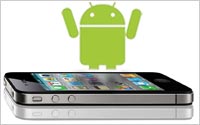Apple Drives Half Of Mobile Messages
- by Mark Walsh @markfwal, December 10, 2012
 Mobile video messaging as a marketing
tool continues to gain ground, with participation in MMS (multimedia messaging service) and traditional SMS campaigns on iOS and Android devices doubling between April and October.
Mobile video messaging as a marketing
tool continues to gain ground, with participation in MMS (multimedia messaging service) and traditional SMS campaigns on iOS and Android devices doubling between April and October.
The finding comes from a semiannual study by MMS provider Mogreet analyzing mobile messaging behavior based on data from 1 million subscribers and more than 5,000 campaigns. The company says it handles more than half of MMS messages delivered by businesses to consumers in the U.S.
The iPhone and Android smartphones remain the most popular smartphone platforms for messaging. iOS users account for more than half of those opting into MMS and text-messaging campaigns, compared to 34% coming through Android phones. Those levels are up from 23.6%, and 16%, respectively, in April. BlackBerry accounted for 7% of opt-in messaging.
Looking at device manufacturers, Apple drove half of commercial MMS and SMS messages, with Samsung a distant second, at 16%, followed by LG (9%), HTC (8%), Motorola (8%) and BlackBerry (5%). “Samsung’s continued presence on this list can, like Apple, can be credited to its new and innovative -- including lower priced options -- product offerings and partnerships with lower cost carriers,” noted the report.
Among U.S. wireless carriers, AT&T and Verizon Wireless led the way, accounting for almost 60% of opt-in messaging traffic, down from 89% in April. Gaining at the expense of its larger rivals was Sprint, which increased its share of messaging to 19% from 8%. Unlike AT&T and Verizon, Sprint has maintained its unlimited data plan while adding the iPhone to its device lineup in late 2011.
The Summer Olympics and 2012 election cycle also helped to drive messaging activity in the second half of 2012, with particular growth in industry categories including retail, media and entertainment. MMS is generally preferred for driving brand awareness via photos or video, while SMS is used for sponsored alerts.
“We expect this trend to continue in 2013,” said Mogreet CEO James Citron, noting that MMS is now supported on 97% of U.S. mobile devices.



What the self serving report from Mogreet fails to mention is that by using a branded video link in an SMS message, the user experience is far superior to the MMS one which is a Mogreet product. Costs less and is infinitely a better user experience that can shared.
Bruce, I'm surprised you feel SMS with a link (which utilizes customer data and requires wifi or a data plan to use) is better than providing the consumer with the entire experience in one send. Many retailers find differently - seeing 3x conversion rate when they switch from the truncated text message to a fully branded experience. As you can guess, in this economy, many companies feel 3x increased response rate for something that costs fractions of pennies more is worth trying.
To find more value out of this report, it should be looked at as guidance for one's 2013 mobile strategies. For example, content creation by iPhone users is exploding and iPhone users overindex in text message program opt-ins, so why not consider a photo sharing contest for these users, etc.
Hope this helps, feel free to reach out directly with questions! Serena
I find the article very encouraging for the SMS A2P ecosystem. Just recently we have been reading that SMS growth is tailing off under pressure from imessage and other closed networks as well as in-app non-SMS messaging. What I would like to see is number of short codes and A2P MOs and MTs over time. Why doesn't www.usshortcodes.com release this information. After all, they get a bucket load of revenue from short code leases. Just wondering.